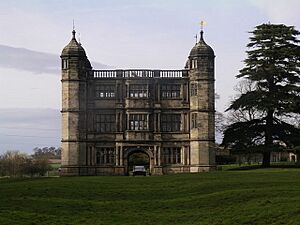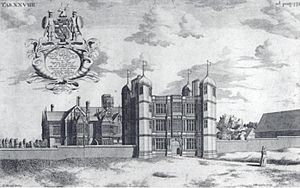Tixall Gatehouse facts for kids
Tixall Gatehouse is a cool old building from the 1500s. It's located near Stafford, in Staffordshire, England. This gatehouse is all that's left of a much bigger house called Tixall Hall, which was taken down in 1927. It's considered a very important historical building, known as a Grade I listed building. Tixall Gatehouse was even a temporary prison for Mary, Queen of Scots for two weeks in 1586.
History of Tixall Gatehouse
For many years, the land of Tixall belonged to the Littleton family. But in 1507, the last Littleton heiress married Sir John Aston. The old medieval house was replaced by a new one around 1555 by Sir Edward Aston, who was a very important local official. The Gatehouse was added a bit later, around 1580.
The Gatehouse is a tall, rectangular building with three floors. Its front is decorated with fancy columns and a railing. It also has four round towers at each corner, topped with small domes and weather vanes.
The Aston family later became very important, earning titles like baronet and Lord. One family member, Walter Aston, 2nd Lord Aston of Forfar, was a Catholic at a time when that was difficult in England. After he passed away, there were some made-up stories, part of something called the "Popish Plot." People falsely claimed that he had met with certain religious leaders at Tixall. They also said that in 1677, meetings happened at Tixall where people supposedly planned to harm King Charles II of England. These were later found to be untrue accusations.
When the sixth Lord Aston died, the estate went to his sister, who had married Thomas Clifford. Around 1780, Clifford built a brand new mansion, but he wisely kept the beautiful old Tudor Gatehouse.
The Cliffords sold the Tixall estate to Earl Talbot in 1835. After that, the property was rented out to different people. The big Tixall Hall was finally torn down in 1927, leaving only the Gatehouse standing. In 1960, the estate was split up and sold off. Luckily, in 1968, a group called the Landmark Trust bought the Gatehouse. They fixed it up, and now people can even rent it for holidays!
Mary, Queen of Scots' Time at Tixall
Mary, Queen of Scots was held prisoner here for two weeks in 1586. Her jailer, Amias Paulet, had checked out the house in 1585 to see if it would be a good place for her to live long-term. Paulet thought the house was suitable. However, he felt bad about making Sir Walter Aston and his large household of 100 people move out. Aston also complained that moving would mess up his farming and force him to sell his animals.
On August 11, 1586, the English authorities decided to act on a plot against Queen Elizabeth I, known as the Babington plot. Mary was out riding near Chartley Castle with her doctor and others. Suddenly, armed soldiers surprised them and took them to Tixall. This was so the soldiers could search Mary's rooms at Chartley and take her important papers.
Queen Elizabeth I's secretary, Francis Walsingham, sent a message on September 25, 1586. He told Paulet not to take Mary back to Chartley. Instead, Elizabeth wanted Mary to go to Fotheringhay Castle. However, Paulet had already taken Mary back to Chartley before he got the new orders. As Mary left Tixall with Paulet and Walter Aston, she cried. She told some poor people at the gate, "I have nothing for you, I am a beggar as well as you, all is taken from me."



